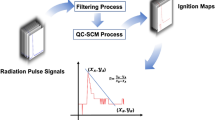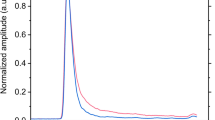Abstract
Neutrons have been extensively used in many fields, such as nuclear physics, biology, geology, medical science, and national defense, owing to their unique penetration characteristics. Gamma rays are usually accompanied by the detection of neutrons. The capability to discriminate neutrons from gamma rays is important for evaluating plastic scintillator neutron detectors because similar pulse shapes are generated from both forms of radiation in the detection system. The pulse signals measured by plastic scintillators contain noise, which decreases the accuracy of n–\(\upgamma\) discrimination. To improve the performance of n–\(\upgamma\) discrimination, the noise of the pulse signals should be filtered before the n–\(\upgamma\) discrimination process. In this study, the influences of the Fourier transform, wavelet transform, moving-average filter, and Kalman algorithm on the charge comparison method, fractal spectrum method, and back-propagation neural network methods were studied. It was found that the Fourier transform filtering algorithm exhibits better adaptability to the charge comparison method than others, with an increasing accuracy of 6.87% compared to that without the filtering process. Meanwhile, the Kalman filter offers an improvement of 3.04% over the fractal spectrum method, and the adaptability of the moving-average filter in back-propagation neural network discrimination is better than that in other methods, with an increase in 8.48%. The Kalman filtering algorithm has a significant impact on the peak value of the pulse, reaching 4.49%, and it has an insignificant impact on the energy resolution of the spectrum measurement after discrimination.






Similar content being viewed by others
References
B. Tang, J. Cai, W.B. Huang et al., Experimental study of silicon carbide neutron detectors. J. Radiat. Res. Radiat. Process. 38(5), 67–72 (2020). https://doi.org/10.11889/j.1000-3436.2020.rrj.38.050702 (in Chinese)
T.M. Shen, J.M. Chen, W.J. Li, A method for material identification based on X-ray dual-energy backscatter detection. Nuclear Tech. 42(6), 060201 (2019). https://doi.org/10.11889/j.0253-3219.2019.hjs.42.060201 (in Chinese)
D.D. Zhou, S.M. You, J. Xin et al., Development of a 4\(\pi\)-phoswich detector for measuring radioactive inert gases. Nuclear Tech. 43(5), 050401 (2020). https://doi.org/10.11889/j.0253-3219.2020.hjs.43.050401 (in Chinese)
J. Zeng, Q.P. Xiang, Y.Z. Zhang et al., Neutron detection efficiency and gamma discrimination of boron-coated straw detectors. Nuclear Tech. 42(7), 070401 (2019). https://doi.org/10.11889/j.0253-3219.2019.hjs.42.070401 (in Chinese)
S.A. Pozzi, M.M. Bourne, S.D. Clarke, Pulse shape discrimination in the plastic scintillator EJ-299-33. Nucl. Instrum. Methods Phys. Res. A 723, 19–23 (2013). https://doi.org/10.1016/j.nima.2013.04.085
L. Chang, Y. Liu, D.U. Long et al., Pulse shape discrimination and energy calibration of EJ301 liquid scintillation detector. Nuclear Tech. 38, 020501 (2015). https://doi.org/10.11889/j.0253-3219.2015.hjs.38.020501 (in Chinese)
X. Zhang, X. Yuan, X.F. Xie et al., Digital delay-line-shaping method for pulse shape discrimination in stilbene neutron detectors and application to fusion neutron measurement at the HL-2A tokamak. Nucl. Instrum. Methods Phys. Res. Sect. A 687, 7–13 (2012). https://doi.org/10.1016/j.nima.2012.05.077
S.A. Pozzi, M.M. Bourne, J.L. Dolan et al., Plutonium metal vs. oxide determination with the pulse-shape-discrimination-capable plastic scintillator EJ-299-33. Nucl. Instrum. Methods Phys. Res. A 767, 188–192 (2014). https://doi.org/10.1016/j.nima.2014.08.002
M.Z. Liu, B.Q. Liu, Z. Zuo et al., A fractal spectrum approach for neutron and gamma pulse shape discrimination was supported by the National Natural Science Foundation of China (41274109), Sichuan Youth Science and Technology Innovation Research Team (2015TD0020), Scientific and Technology. Chin. Phys. C 40, 066201 (2016). https://doi.org/10.1088/1674-1137/40/6/066201
D.I. Shippen, M.J. Joyce, M.D. Aspinall, A wavelet packet transform inspired method of neutron-gamma discrimination. IEEE Trans. Nucl. Sci. 57, 2617–2624 (2009). https://doi.org/10.1109/TNS.2010.2044190
X. Chen, R. Liu, X.X. Lu et al., Analysis of the three digital n/y discrimination algorithms for liquid scintillation neutron spectrometry. Radiat. Meas. 49, 13–18 (2013). https://doi.org/10.1016/j.radmeas.2012.12.010
K.A.A. Gamage, M.J. Joyce, N.P. Hawkes, A comparison of four different digital algorithms for pulse-shape discrimination in fast scintillators. Nucl. Instrum. Methods Phys. Res. A 642, 78–83 (2011). https://doi.org/10.1016/j.nima.2011.03.065
T. Tambouratzis, D. Chernikova, I. Pázsit, A comparison of artificial neural network performance: The case of neutron/gamma pulse shape discrimination, in IEEE Symposium on Computational Intelligence for Security and Defense Applications, pp. 88–95 (2013). https://doi.org/10.1109/CISDA.2013.6595432
N. Yildiz, S. Akkoyun, Neural network consistent empirical physical formula construction for neutron-gamma discrimination in gamma ray tracking. Ann. Nucl. Energy 51, 10–17 (2013). https://doi.org/10.1016/j.anucene.2012.07.042
B. Deng, R. Tao, Q.I. Lin et al., Fractional Fourier transform and time-frequency filtering. Syst. Eng. Electron. 26(10), 1357–1405 (2004). (in Chinese)
T.G. Payne, A.D. Southam, T.N. Arvanitis et al., A signal filtering method for improved quantification and noise discrimination in Fourier transform ion cyclotron resonance mass spectrometry-based metabolomics data. J. Am. Soc. Mass Spectrom. 20, 1087–1095 (2009). https://doi.org/10.1016/j.jasms.2009.02.001
S. Hosur, A.H. Tewfik, Wavelet transform domain adaptive FIR filtering. IEEE Trans. Signal Process. 45, 617–630 (1997). https://doi.org/10.1109/78.558477
H. Singh, R. Mehra, Discrete wavelet transform method for high flux n-\(\gamma\) discrimination with liquid scintillators. IEEE Trans. Nucl. Sci. 64, 1–7 (2017). https://doi.org/10.1109/TNS.2017.2708602
J.A. Burns, E.M. Cliff, C. Rautenberg, A distributed parameter control approach to optimal filtering and smoothing with mobile sensor networks. Conference on Control & Automation. (2009). https://doi.org/10.1109/MED.2009.5164536
Y. Zheng, S. Chen, W. Tan et al., Detection of tissue harmonic motion induced by ultrasonic radiation force using pulse-echo ultrasound and a Kalman filter. IEEE Trans. Ultrason. Ferroelectr. Freq. Control 54, 290–300 (2007). https://doi.org/10.1109/TUFFC.2007.243
DEMON Collaboration, M. Moszynski, G. Bizard et al., Study of n-\(\gamma\) discrimination by digital charge comparison method for a large volume liquid scintillator. Nucl. Instrum. Methods Phys. Res. A 317, 262–272 (1992). https://doi.org/10.1016/0168-9002(92)90617-D
Michael Barnsley, Fractals everywhere. Am. Math. Mon. 97, 266–268 (1990). https://doi.org/10.2307/2324711
B.B. Mandelbrot, W.H. Freeman and Company. Fractal geometry of nature. Coll. Math. J. 15, 175–177 (1984). https://doi.org/10.2307/2686529
J.W. Cooley, P.A.W. Lewis, P.D. Welch, The fast Fourier transform and its applications. IEEE Trans. Educ. 12, 27–34 (1969). https://doi.org/10.1109/TE.1969.4320436
A.T.C. Goh, Back-propagation neural networks for modeling complex systems. Artif. Intell. Eng. 9, 143–151 (1995). https://doi.org/10.1016/0954-1810(94)00011-S
J.B. Allen, Short term spectral analysis, synthesis, and modification by discrete Fourier transform. IEEE Trans. Acoust. Speech Signal Process. 25, 235–238 (1977). https://doi.org/10.1109/TASSP.1977.1162950
Y.S. Xu, J.B. Weaver, D.M. Healy et al., Wavelet transform domain filters: a spatially selective noise filtration technique. IEEE Trans. Image Process. 3, 747–758 (1994). https://doi.org/10.1109/83.336245
I. Daubechies, The wavelet transform, time-frequency localization and signal analysis. IEEE Trans. Inf. Theory 36, 961–1005 (1990). https://doi.org/10.1109/18.57199
A. Loukas, A. Simonetto, G. Leus, Distributed autoregressive moving average graph filters. IEEE Signal Process. Lett. 22, 1931–1935 (2015). https://doi.org/10.1109/LSP.2015.2448655
J.Y. Wang, J. Liang, F. Gao et al., A method to improve the dynamic performance of a moving average filter-based PLL. IEEE Trans. Power Electron. 30, 5978–5990 (2015). https://doi.org/10.1109/TPEL.2014.2381673
J.L. Anderson, An ensemble adjustment Kalman filter for data assimilation. Mon. Wea. Rev. 129(12), 2884–2903 (2001)
S.J. Julier, J.K. Uhlmann, New extension of the Kalman filter to nonlinear systems. Proc. SPIE 3068, Signal Processing, Sensor Fusion, and Target Recognition VI, 28 July 1997. https://doi.org/10.1117/12.280797
G. Burgers, P.J.V. Leeuwen, G. Evensen, Analysis scheme in the ensemble Kalman filter. Mon. Wea. Rev. 126(6), 1719–1724 (1998)
J.B. Birks, The Theory and Practice of Scintillation Counting: International Series of Monographs in Electronics and Instrumentation (1964). https://doi.org/10.1016/C2013-0-01791-4
R. Coulon, M. Becht, J. Dumazert et al., Simulation of scintillation signal as a help in phoswich systems conception, in IEEE Nuclear Science Symposium, Medical Imaging Conference, Atlanta, GA, USA, 21-28 Oct. 2017. https://doi.org/10.1109/NSSMIC.2017.8533083
B. D’Mellow, M.D. Aspinall, R.O. Mackin et al., Digital discrimination of neutrons and \(\gamma\)-rays in liquid scintillators using pulse gradient analysis. Nuclear Inst. Methods Phys. Res. A 578, 191–197 (2007). https://doi.org/10.1016/j.nima.2007.04.174
Author information
Authors and Affiliations
Contributions
All authors contributed to the study conception and design. Material preparation, data collection and analysis were performed by Zhuo Zuo, Hao-Ran Liu, Yu-Cheng Yan and Bing-Qi Liu. The first draft of the manuscript was written by Zhuo Zuo and Song Zhang, and all authors commented on previous versions of the manuscript. All authors read and approved the final manuscript.
Corresponding author
Additional information
This work was supported by the Key Natural Science Projects of the Sichuan Education Department (No. 18ZA0067) and the Key Science and Technology Projects of Leshan (No. 19SZD117).
Rights and permissions
About this article
Cite this article
Zuo, Z., Liu, HR., Yan, YC. et al. Adaptability of n–\(\upgamma\) discrimination and filtering methods based on plastic scintillation. NUCL SCI TECH 32, 28 (2021). https://doi.org/10.1007/s41365-021-00865-3
Received:
Revised:
Accepted:
Published:
DOI: https://doi.org/10.1007/s41365-021-00865-3




